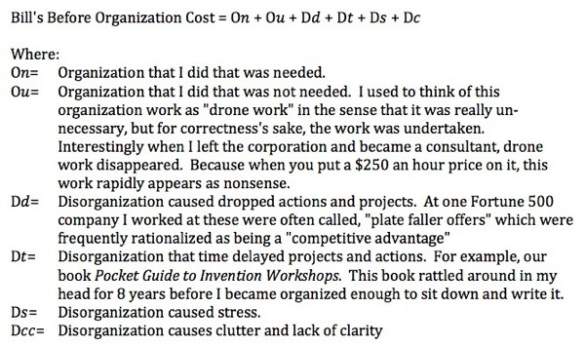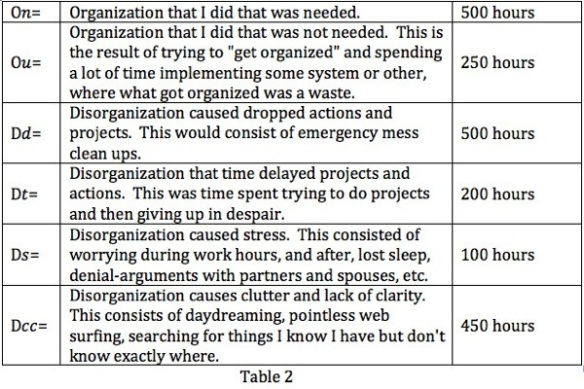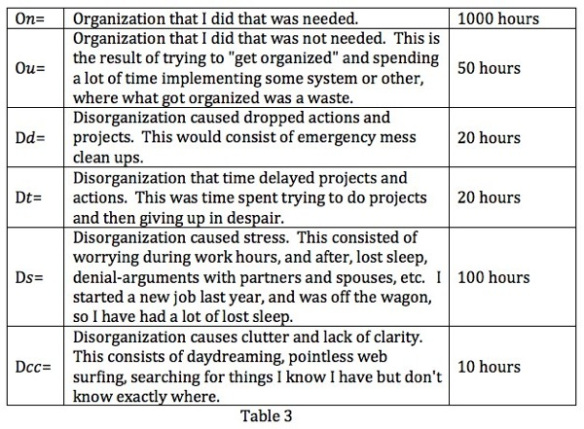Introduction:
I saw this great article on bulbous bowed ships a month or so ago. The key illustration in the article is of the natural bow wave of displacement hulls (green below), the bow wave of the submerged bulbous bow (blue line) and the resultant combined wave (red line).
Figure 1 - Source: GlobalSecurity.org
Bulbous bows reduce the drag on ships. The energy savings can be huge, like 500%. Since reading the article, I haven’t been able to stop reflecting on how GTD reduces drag … like a bulbous bow. Wait, stay with me now! And, I’ve been exploring analogies between how GTD works and how bulbous bows work. In this post, I’m going to explore how the analogy fits, and use the analogy to articulate some of the visceral sensations I’ve experienced in (re)starting GTD.
So what?
This analogy allows me to articulate some of the visceral sensations I experience when re/starting GTD. And, it was a stepping-stone for me to quantify component costs of organizing that I experience.
Visceral Sensations:
In the beginning I was disorganized. For example, my wife said “I have to have a door that I can close on Bill’s office, then, ‘it’ is OK.” This starting point is represented with the green line on Figure 1. As I implemented GTD I had a sense that the hills I was climbing, were flattening out (shift from green to blue in Figure 1). The bow wave became less steep. Work began to flow without drama, I was able to stop using todo lists. Crises slowed down, and then, for the most part, stopped. I developed a “situation awareness” of all my projects that allowed me to prioritize my time dynamically, and cut down dramatically on stress and energy drain from work.
Now the quantification part. To try and put an equation around my experience, I set up costs of organization as follows:

Equation 1
Just for the sake of illustration, I’ll subjectively make up scores for these costs before I got on the GTD wagon. Assuming there are 2,000 working hours in the year, I would apportion the hours in each category as:

Now After:
My costs of organizing before GTD were substantially higher than they are now. My current costs of organization I would guess are as follows:

I admit this is an anecdotal comparison. But let’s not forget the point, I’m trying to get a handle on how to articulate how GTD has freed up time and mental strain.
Back to visceral sensations:
My dominant visceral sensation from shifting to GTD was a sense of relief. Let’s compare before and after and see why:

Comparison 1
Table 4 displays each of these elements with my subjective sense of what happened.
Table 4
OK, so this comparison before and after GTD compares the green with the blue line. Before has lots of drag, after has a ton less drag, huge savings in time and energy and clarity. Actually, one of the hardest things to describe well about GTD, is the feeling you get as you calmly work through next actions and projects, and realize that you are catching up.
Read that sentence again!
How long has it been since you had the hope of being caught up? I’ve spent my adult life behind. But as you implant GTD and find the right mix of digital/paper/people/reading to keep you humming, you begin to have a glimmer of hope that you can get everything done. Viscerally what this feels like to me, is being under water, like 10 meters under water, and being short of breath. You are down and you know you need to go up, you force yourself to be calm as you swim as fast as you can. At some point, you realize that you are going to make it to the surface before your air runs out. That point of realization, is what going from the green bow wave to the blue bow wave *feels* like. As you implement GTD, you start down wave from the green line. You begin to see light.
In my first cut at implementing GTD, this release sensation, and the feeling of being on top of my work for the first time in my adult life, was very powerful. Almost intoxicating. My wife said “Why are you so happy?” after the first week of GTD. As I fall off the GTD wagon, and then get back on, the seeing light sensation is not as great. But, it is still there. After getting back on the wagon over December 2011, I’ve had a month of clear mind.
Even though I have a clear mind, I find that I am confronting many bad habits picked up in decades spent being behind. For example, I find that when I think about prepping a class meeting for my quant methods undergrads, I automatically and instinctively panic, start feeling guilty for not having the prep done already (even though I haven’t had time to do it, guilt is free once it become part of habit). So panic, fear, and guilt are there for many tasks I have to do. But what I’m finding is that so is a quiet side of my mind. A calm, confident side of my mind. This calm/quiet/confident part of me over this past month, has taken the tasks away from my habitual panic, guilt, and fear side. I find myself saying “Why am I feeling guilty about this, I have a ton of time to get this done. Oh, and another idea I can put in that class…”
Seeing the light, having the hope of catching up, allows me to SPEND my time before the task, much more productively. Instead of worrying, I’ve dropped the worry, I’ve shifted to reflection. As I reflect on the class I need to teach, I find that I am able to use the information on where the minds of the students are, and develop smaller, more focused Excel exercises. I am much more in touch with the students when I’m not self-criticizing about not being omniscient.
The blue line is hope. The blue line is GTD flow.
What About The Red Line?
Here’s a refresher on Figure 1:
Figure 1 - Source: GlobalSecurity.org
I think the red line is a metaphor for what happens when ahem …, “a certain person” falls off the GTD wagon. Immediately, I ooops, … “they” become less efficient, “they” have a visceral sense of the bow wave of daily work, becoming steeper. This kicks off panic. Panic decreases clarity and increases self-criticism. In the face of chaos and criticism, interruptions become drop everything crises.
Speaking of crises, how does one’s boss know to walk in during panic chaos and self-criticism moments? “Whoops” the person has another “suppository project.” Drop EVERYTHING NOW!
Summary:
When you implement GTD, you have many visceral responses. Because GTD works on both subconscious and conscious levels, these visceral sensations are important signals. Signals that you are making progress. Signals that you may be back sliding. When you get into GTD work flow, you have a sense of stress relief, a sense of time slowing down, a sense of clarity of mind, these are good. All nourishing to, … mind-like-water.
However, I find that some people I help implement GTD, respond to these positive visceral sensations, with a lot of self criticism. Self criticism as you implement GTD drives you from the blue or red curve, back to the green curve. Exhausting. That is what falling off the GTD wagon fells like.
I hear questions like “I thrive on chaos. What will I do if I don’t have chaos in my life to thrive on?” These can really drag over-thinkers to the green bow wave in a hurry. Remember, if you can’t get everything done, the most likely cause is that you are not organized enough. When you get organized enough, you surf down from the green bow wave, to red, and if you buckle down, to the blue. You can feel it. You will feel it, just focus, breathe, and organize. When you panic, organize more, and then get back on the wagon.
bill meade

I like the metaphor but the 500% energy savings seem to be impossible. In my opinion you cannot save more than 100% of the energy that is at your disposal!
If you follow the link, you will tap into much greater expertise than I have. I will edit my post to be more correct. What I should have said is that the drag is cut by 500%. Not the total energy. But I’ll read up and make sure that I’ve got my facts specific before I update the post.
Thanks!
bill meade
Read “addicted to unhappiness”. You have psychological barriers that you can fix.
I will! ADDICTED TO UNHAPPINESS has been coming up in the evolutionary psych and cognitive psych that I’m reading right now.
I’m writing RestartGTD for two reasons: (1) To articulate my thinking about GTD and the evolving organization GTD brings to my life. And (2), because when I open my kimono about what is going on in my head, my students and clients find it ENORMOUSLY beneficial that they can TRY GTD without have to channel David Allen or to otherwise be PERFECT. Feet of clay can take steps too.
I have panic attacks, always have. I know there are a lot of things to be dealt with in my psyche. But, the connection to GTD makes sense in this context. In a way, GTD becomes a lens into the self. GTD facilitates constructive reflection. GTD allows me to withhold judgements and sense what is going on both consciously and unconsciously.
In this post, I was trying to drill into the overlap of conscious and unconscious effects of GTD.Three years into GTD, I’m gaining more and more insight into what works. And more ability to let go of the baggage and stuff that does not work.
Thanks for the tip on the book!
bill meade
many aspects of gtd for me are also very much related to building habits. once a certain action becomes a habit you don’t even need to think about doing it, it just happens (sort of automatically).
As I do GTD for longer and longer, I concentrate a lot less on habits. And, a lot more on my subjective state of mind. For example, after getting back on the GTD wagon last December, I find that work tasks are becoming less panic inducing. That is, when I see I need to grade my MBA student blog posts for the week, before last December I would have panic-ed and procrastinated. Since getting back on the wagon, I’m finding that the panic/procrastinate speed bumps in the way of work, are rapidly reducing in size. My work for the past three months has been flowing much more freely as I’ve avoided drama moving from task to task to task.
Every time I get back on the wagon, I re-discover the freedom that comes from not needing todo lists. I think of this as having “situational awareness.” When you can depend on your situational awareness to move your attention from task to task, it is a beautiful thing.
bill meade
Nice article! I like your quantitative approach to trying to estimate the benefits of GTD. Explaining the benefits of GTD to organizations is high on my list of priorities right now. I’m reading a book called “Breakthrough Learning” that is very interesting in this area, that reminds us that the value of learning is in the behavior changes that result in increases in effectiveness and efficiency. But effectiveness, which is what knowledge workers really need to focus on (efficiency is a measure from a previous generation of workers) is very hard to quantify. There are so many factors that could come into play when effectiveness changes, and how does one measure effectiveness to start with? Your analysis provides a unique framework for that discussion.
I specialize in quantifying hard to quantify subjects. I wrote my dissertation on measuring the competitive draw across soft drink competitors. I did PhD minors in systems science and evolutionary ecology to get my head outside conventional competition measurement. I’d be happy to talk with you about alternative analytical frameworks to quantify effectiveness (doing the right things) and efficiency (doing things right). It might make a good seed post for this blog where interested parties can chime in and throw lightening bolts. Comments are often way better than the posts!
bill meade
Bill: Thanks for your note. I am intrigued by your approach, and would like to talk more. Many alternative “time management” training courses offer benefits such as “45% improvement in time management”. These are usually based on surveys that respondants fill out. The benefits of GTD, as you know, lie beyond efficiencies, and are in the realm of effectiveness. We have personally experienced what it is like to have relaxed control, and the ability to focus on what is important. But how do you quantify this? What is the value of a creative idea, and how would you demonstrate that you wouldn’t have had it without GTD? In my brief tenure with the David Allen Company, I have already met many people that have experienced some degree of mind like water. But I have also met many people that have not had this experience, and some of them have tried GTD, but been unable to sustain it. My role at the David Allen Company is to be an ambassador for GTD, and that means I need to be able to explain, and often quantify, the benefits. Of course, the best way to do this is to get them to try it- a very Zen-like approach. But sometimes, before they engage in the experience, they need intellectual reasons or confirmation. It sounds like this is an area you excel in- using quantitavie methods to interpet and explain experience.
I look forward to further discussion.
Regards,
Scott Anderson
I’d love to talk, but it will have to wait until next week. I’m teaching “Getting (re)started with GTD” at Concordia University (where I work) Friday from 5:00 pm to 9:00 pm and then Saturday from 9:00 am to 5:00 pm. Sunday is lost to decompression. My email is [email protected]. Send me a time that is good for you next week!
bill meade